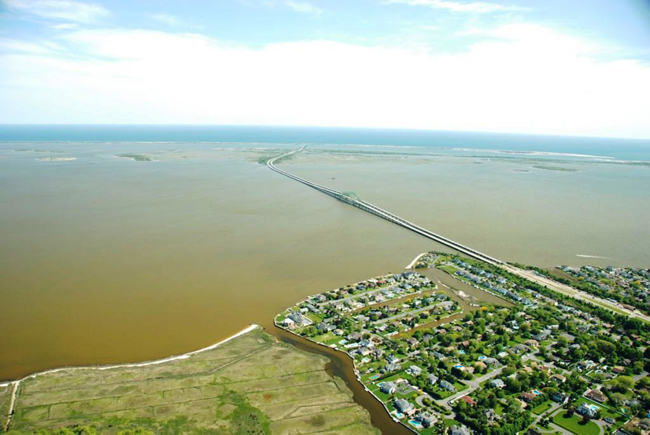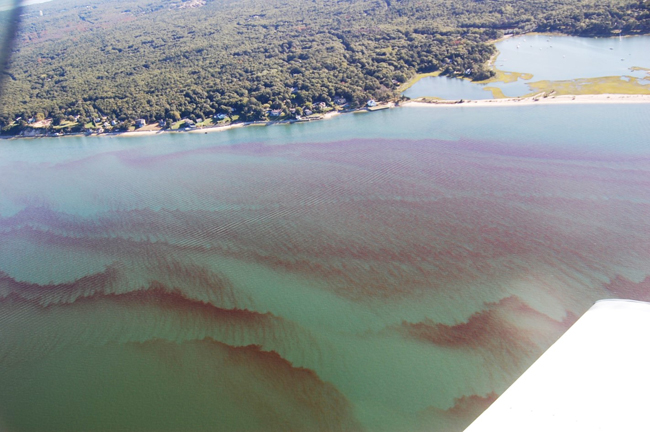
A brown tide bloom in Great South Bay, Suffolk County, NY. Credit The Gobler Lab.
New York Sea Grant created a webpage to link users to the NYSDEC's "Suspicious Marine Algae Public Reporting Tool" and used the 2020 HAB season to successfully conduct a test of the new public outreach effort.
– By Quay Dortch, Ph.D., Senior HAB Scientist, NOAA/NOS/NCCOS/Competitive Research Program, E: quay.dortch@noaa.gov
Stony Brook, NY, January 22, 2021 - Brown tides and other harmful algal blooms (HABs) are becoming a recurrent seasonal issue in the coastal waters of New York’s Suffolk County. A NCCOS brown tide research project provided the funding for the development of a public “suspicious” marine algae reporting tool for archiving HAB data and for citizen scientists to report suspicious blooms.
Suffolk County on Long Island, is New York’s easternmost and fourth-most populous county. Suffolk County is bordered on three sides by water; Long Island Sound, Block Island Sound, and the New York Bight. These coastal water bodies surrounding Suffolk County are often plagued by HABs such as brown tides, rust tides, red tides (PSP/Alexandrium) and blue-green algae. There were reports of mahogany tides across Long Island in May 2020 which is attributed to Prorocentrum minimum being propagated by increased nitrogen.
Suffolk County conducts seasonal HAB monitoring in conjunction with several partners, e.g., NY Department of Environmental Control (DEC) and The Gobler Lab at Stony Brook University. Suffolk County has collected more than fifteen years of water quality and HAB species identification data. These data were not archived in a format easily visualized or accessible by the public or non-technical audiences.

A 2016 toxic ‘rust tide’ in the Peconic Estuary, Suffolk County, NY. Credit: USGC Auxiliary via NYSG.
The NCCOS brown tide project partner, New York Sea Grant (NYSG), identified the need to archive these historical HAB monitoring data in a more accessible manner and the project lead investigator (Dr. Christopher Gobler of Stony Brook University) agreed with the benefits. While Suffolk County was very supportive of this proposal, no funds were available to contribute towards this effort.
Using the re-budgeted NCCOS funds, NYSG ran an internal competition to hire a student with ArcGIS experience to create the reporting tool. Using the NY DEC Freshwater Suspicious Algae Reporting Tool as a template and reference point, a marine version was created. The marine tool allows users to report freshwater blooms to the NY DEC.
This Suspicious Marine Algae Public Reporting Tool acts as a central repository archive of seasonal HAB monitoring results and encourages public participation in seasonal HAB monitoring. A benefit from public participation is that Suffolk County will be able to use these reports to make decisions about the data collection, e.g., modify the sampling protocol and guide field staff deployment. Ultimately, this tool will help complete the goal of facilitating public access to ‘real time’ information, outlined in the Suffolk County HAB Action Plan (PDF).
The reporting tool form captures basic information as follows:
- Contact information
- Location of HAB event
- Interactive map to pinpoint the location
- General descriptive information about the HAB event
- Color, odor, incidental fish kills, coverage
- Upload photographs (optional)
The reporting tool is designed to automatically send an alert to Suffolk County staff, each time a new report is submitted. NYSG created a webpage to link users to this reporting tool and used the 2020 HAB season to successfully test this tool. NYSG also provided support to Suffolk County Government to enter the results of the 2020 HAB monitoring season into the tool database.
Says Dr. Katherine Bunting-Howarth, Associate Director of New York Sea Grant Institute and Assistant Director, Cornell Cooperative Extension, “New York Sea Grant is pleased that this ECOHAB partnership has been able to enhance the service Suffolk County managers can provide to residents in coastal communities that may be adversely impacted by these harmful algal bloom events.”
This effort was supported through the NCCOS ECOHAB project Resolving the Effects of Resource Availability, Predation, and Competition on Brown Tide Dynamics via Metatranscriptomics.
More Info: New York Sea Grant
New York Sea Grant (NYSG), a cooperative program of Cornell University
and the State University of New York (SUNY), is one of 34 university-based
programs under the National Oceanic and Atmospheric Administration’s
National Sea Grant College Program.
Since 1971, NYSG has represented a statewide network of integrated
research, education and extension services promoting coastal community
economic vitality, environmental sustainability and citizen awareness
and understanding about the State’s marine and Great Lakes resources.
Through NYSG’s efforts, the combined talents of university scientists
and extension specialists help develop and transfer science-based
information to many coastal user groups—businesses and industries,
federal, state and local government decision-makers and agency managers,
educators, the media and the interested public.
The program maintains Great Lakes offices at Cornell University, SUNY
Buffalo, SUNY Oswego and the Wayne County Cooperative Extension office
in Newark. In the State's marine waters, NYSG has offices at Stony Brook
University in Long Island, Brooklyn College and Cornell Cooperative
Extension in NYC and Kingston in the Hudson Valley.
For updates on Sea Grant activities: www.nyseagrant.org has RSS, Facebook, Twitter, Instagram, and YouTube links. NYSG offers a free e-list sign up via www.nyseagrant.org/nycoastlines for its flagship publication, NY Coastlines/Currents, which is published quarterly. Our program also produces an occasional e-newsletter,"NOAA Sea Grant's Social Media Review," via its blog, www.nyseagrant.org/blog.